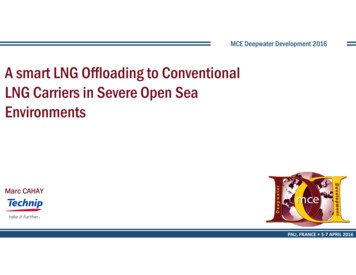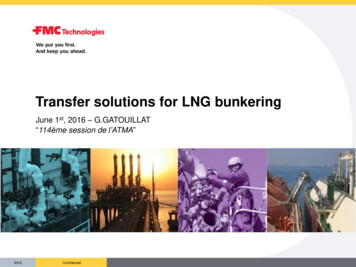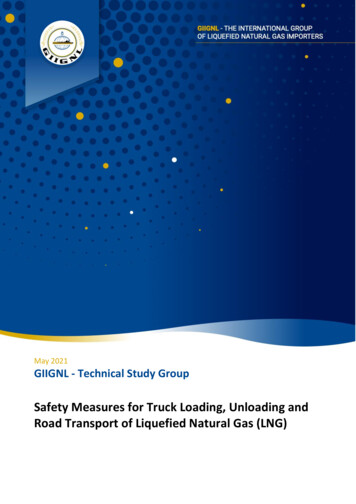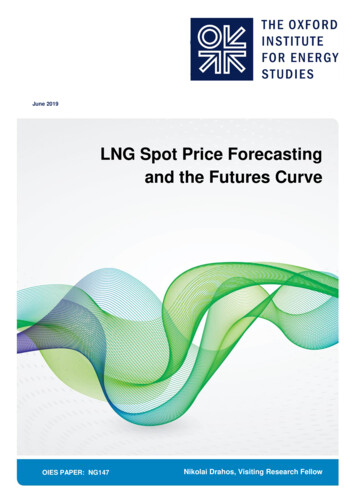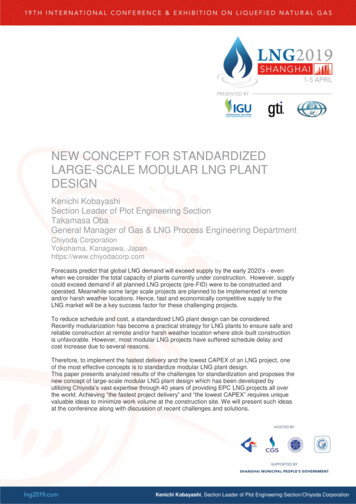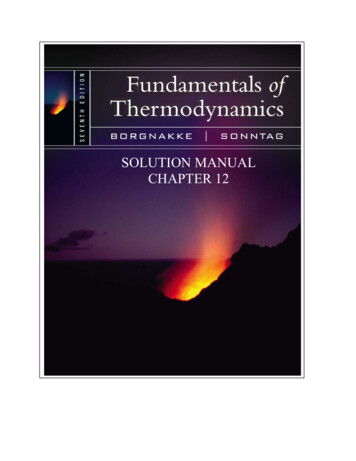
Transcription
SOLUTION MANUALCHAPTER 12
Borgnakke and SonntagCONTENTSUBSECTIONPROB NO.In-Text Concept Questionsa-gConcept problems1-13Brayton cycles, gas turbines14-24Regenerators, Intercoolers, nonideal cycles 25-39Ericsson cycle40-41Jet engine cycles42-53Air standard refrigeration cycles54-59Otto cycles60-82Diesel cycles83-94Stirling and Carnot cycles95-101Atkinson and Miller cycles102-109Combined cycles110-114Availability or Exergy Concepts115-123Review124-130Problems re-solved with the Pr, vr functions from A.7.2:32, 37, 74 see also 79, 80, 91, 101 and 127Excerpts from this work may be reproduced by instructors for distribution on a not-for-profit basis fortesting or instructional purposes only to students enrolled in courses for which this textbook has beenadopted. Any other reproduction or translation of this work beyond that permitted by Sections 107 or 108of the 1976 United States Copyright Act without the permission of the copyright owner is unlawful.
Borgnakke and SonntagIn-Text Concept QuestionsExcerpts from this work may be reproduced by instructors for distribution on a not-for-profit basis fortesting or instructional purposes only to students enrolled in courses for which this textbook has beenadopted. Any other reproduction or translation of this work beyond that permitted by Sections 107 or 108of the 1976 United States Copyright Act without the permission of the copyright owner is unlawful.
Borgnakke and Sonntag12.aThe Brayton cycle has the same 4 processes as the Rankine cycle, but the T-s andP-v diagrams look very different; why is that?The Brayton cycle have all processes in the superheated vapor (close toideal gas) region. The Rankine cycle crosses in over the two-phase region.12.bIs it always possible to add a regenerator to the Brayton cycle? What happenswhen the pressure ratio is increased?No. When the pressure ratio is high, the temperature after compression ishigher than the temperature after expansion. The exhaust flow can then notheat the flow into the combustor.12.cWhy would you use an intercooler between compressor stages?The cooler provides two effects. It reduces the specific volume and thusreduces the work in the following compressor stage. It also reduces thetemperature into the combustor and thus lowers the peak temperature. Thismakes the control of the combustion process easier (no autoignition oruncontrollable flame spread), it reduces the formation of NOx that takesplace at high temperatures and lowers the cooling requirements for thechamber walls.Excerpts from this work may be reproduced by instructors for distribution on a not-for-profit basis fortesting or instructional purposes only to students enrolled in courses for which this textbook has beenadopted. Any other reproduction or translation of this work beyond that permitted by Sections 107 or 108of the 1976 United States Copyright Act without the permission of the copyright owner is unlawful.
Borgnakke and Sonntag12.dThe jet engine does not produce shaft work; how is power produced?The turbine produces just enough shaft work to drive the compressor and it makesa little electric power for the aircraft. The power is produced as thrust of theengine. In order to exhaust the gases at high speed they must be accelerated so thehigh pressure in the turbine exit provides that force (high P relative to ambient).The high P into the turbine is made by the compressor, which pushes the flowbackwards, and thus has a net resulting force forwards on the blades transmittedto the shaft and the aircraft. The outer housing also has a higher pressure insidethat gives a net component in the forward direction.Excerpts from this work may be reproduced by instructors for distribution on a not-for-profit basis fortesting or instructional purposes only to students enrolled in courses for which this textbook has beenadopted. Any other reproduction or translation of this work beyond that permitted by Sections 107 or 108of the 1976 United States Copyright Act without the permission of the copyright owner is unlawful.
Borgnakke and Sonntag12.eHow is the compression in the Otto cycle different from the Brayton cycle?The compression in an Otto cycle is a volume reduction dictated by thepiston motion. The physical handles are the volumes V1 and V2.The compression in a Brayton cycle is the compressor pushing on the flowso it determines the pressure. The physical control is the pressure P2 determinedby how much torque you drive the shaft with.Excerpts from this work may be reproduced by instructors for distribution on a not-for-profit basis fortesting or instructional purposes only to students enrolled in courses for which this textbook has beenadopted. Any other reproduction or translation of this work beyond that permitted by Sections 107 or 108of the 1976 United States Copyright Act without the permission of the copyright owner is unlawful.
Borgnakke and Sonntag12.fHow many parameters do you need to know to completely describe the Ottocycle? How about the Diesel cycle?Otto cycle. State 1 (2 parameters) and the compression ratio CR and theenergy release per unit mass in the combustion, a total of 4 parameters. With thatinformation you can draw the diagrams in Figure 11.28. Another way of lookingat it is four states (8 properties) minus the four process equations (s2 s1, v3 v2,s4 s3 and v4 v1) gives 4 unknowns.Diesel cycle. Same as for the Otto cycle namely 4 parameters. The onlydifference is that one constant v process is changed to a constant P process.Excerpts from this work may be reproduced by instructors for distribution on a not-for-profit basis fortesting or instructional purposes only to students enrolled in courses for which this textbook has beenadopted. Any other reproduction or translation of this work beyond that permitted by Sections 107 or 108of the 1976 United States Copyright Act without the permission of the copyright owner is unlawful.
Borgnakke and Sonntag12.gThe exhaust and inlet flow processes are not included in the Otto or Diesel cycles.How do these necessary processes affect the cycle performance?Due to the pressure loss in the intake system and the dynamic flow processwe will not have as much mass in the cylinder or as high a P as in a reversibleprocess. The exhaust flow requires a slightly higher pressure to push the flow outthrough the catalytic converter and the muffler (higher back pressure) and thepressure loss in the valve so again there is a loss relative to a reversible process.Both of these processes subtract a pumping work from the net work out of theengine and a lower charge mass gives less power (not necessarily lowerefficiency) than otherwise could be obtained.Excerpts from this work may be reproduced by instructors for distribution on a not-for-profit basis fortesting or instructional purposes only to students enrolled in courses for which this textbook has beenadopted. Any other reproduction or translation of this work beyond that permitted by Sections 107 or 108of the 1976 United States Copyright Act without the permission of the copyright owner is unlawful.
Borgnakke and SonntagConcept-Study Guide ProblemsExcerpts from this work may be reproduced by instructors for distribution on a not-for-profit basis fortesting or instructional purposes only to students enrolled in courses for which this textbook has beenadopted. Any other reproduction or translation of this work beyond that permitted by Sections 107 or 108of the 1976 United States Copyright Act without the permission of the copyright owner is unlawful.
Borgnakke and Sonntag12.1Is a Brayton cycle the same as a Carnot cycle? Name the four processes.No. The Brayton cycle approximates a gas turbine.1-2:2-3:3-4:4-1:An isentropic compression (constant s)An isobaric heating (constant P)An isentropic expansion (constant s)An isobaric cooling, heat rejection (constant P)CompressorCombustorTurbineHeat exchangerComment: This cycle is the same as the Rankine cycle 4 processes, but it takesplace in the ideal gas region of states. The last process does not existin the real gas turbine which is an open cycle.Excerpts from this work may be reproduced by instructors for distribution on a not-for-profit basis fortesting or instructional purposes only to students enrolled in courses for which this textbook has beenadopted. Any other reproduction or translation of this work beyond that permitted by Sections 107 or 108of the 1976 United States Copyright Act without the permission of the copyright owner is unlawful.
Borgnakke and Sonntag12.2Why is the back work ratio in the Brayton cycle much higher than in the Rankinecycle?Recall the expression for shaft work in a steady flow devicew v dPThe specific volume in the compressor is not so much smaller than thespecific volume in the turbine of the Brayton cycle as it is in the pump(liquid) compared to turbine (superheated vapor) in the Rankine cycle.Excerpts from this work may be reproduced by instructors for distribution on a not-for-profit basis fortesting or instructional purposes only to students enrolled in courses for which this textbook has beenadopted. Any other reproduction or translation of this work beyond that permitted by Sections 107 or 108of the 1976 United States Copyright Act without the permission of the copyright owner is unlawful.
Borgnakke and Sonntag12.3For a given Brayton cycle the cold air approximation gave a formula for theefficiency. If we use the specific heats at the average temperature for each changein enthalpy will that give a higher or lower efficiency?The specific heats are increasing functions of temperature. As the expression forthe efficiency is from p.477η 1 h4 h1CP 4-1 T4 T1 1 Ch3 h2P 3-2 T3 T2The average T from 4 to 1 is lower than the average T from 2 to 3 and thereforethe ratio of the two specific heats is lower than one yielding a higher efficiencythan the cold air approximation gives.Excerpts from this work may be reproduced by instructors for distribution on a not-for-profit basis fortesting or instructional purposes only to students enrolled in courses for which this textbook has beenadopted. Any other reproduction or translation of this work beyond that permitted by Sections 107 or 108of the 1976 United States Copyright Act without the permission of the copyright owner is unlawful.
Borgnakke and Sonntag12.4Does the efficiency of a jet engine change with altitude since the density varies?No, just like the standard Brayton cycle the simple model performancedepends only on the compression ratio.12.5Why are the two turbines in Figures 12.7-8 not connected to the same shaft?Such a configuration gives a little more flexibility in the control of thecycle under varying loads. The two turbines would then not have to run at thesame speed for various power output levels.Excerpts from this work may be reproduced by instructors for distribution on a not-for-profit basis fortesting or instructional purposes only to students enrolled in courses for which this textbook has beenadopted. Any other reproduction or translation of this work beyond that permitted by Sections 107 or 108of the 1976 United States Copyright Act without the permission of the copyright owner is unlawful.
Borgnakke and Sonntag12.6Why is an air refrigeration cycle not common for a household refrigerator?The capacity of the air cycle per mass flowing through the system is verysmall compared with the vapor compression cycle. The cycle also includes theexpander which is one more piece of equipment that will add cost andmaintenance requirements to the system.Excerpts from this work may be reproduced by instructors for distribution on a not-for-profit basis fortesting or instructional purposes only to students enrolled in courses for which this textbook has beenadopted. Any other reproduction or translation of this work beyond that permitted by Sections 107 or 108of the 1976 United States Copyright Act without the permission of the copyright owner is unlawful.
Borgnakke and Sonntag12.7Does the inlet state (P1, T1) have any influence on the Otto cycle efficiency? Howabout the power produced by a real car engine?Very little. The efficiency for the ideal cycle only depends on compressionratio when we assume cold air properties. The u’s are slightly non-linear in T sothere will be a small effect.In a real engine there are several effects. The inlet state determines thedensity and thus the total mass in the chamber. The more mass the more energy isreleased when the fuel burns, the peak P and T will also change which affects theheat transfer loss to the walls and the formation of NOx (sensitive to T). Thecombustion process may become uncontrollable if T is too high (knocking). Someincrease in P1 like that done by a turbo-charger or super-charger increases thepower output and if high, it must be followed by an intercooler to reduce T1. If P1is too high the losses starts to be more than the gain so there is an optimum level.12.8For a given compression ratio does an Otto cycle have higher or lower efficiencythan a diesel cycle?This is actually not clear from the formula’s so we need to refer to the T-sdiagram where we see that the average T at which the heat is added is higher forthe Otto cycle than the diesel cycle for the same compression ratio. Howeversince the diesel cycle runs with much higher compressions ratios than the Ottocycle most typical diesel cycles have higher efficiency than typical Otto cycles.Excerpts from this work may be reproduced by instructors for distribution on a not-for-profit basis fortesting or instructional purposes only to students enrolled in courses for which this textbook has beenadopted. Any other reproduction or translation of this work beyond that permitted by Sections 107 or 108of the 1976 United States Copyright Act without the permission of the copyright owner is unlawful.
Borgnakke and Sonntag12.9How many parameters do you need to know to completely describe the Atkinsoncycle? How about the Miller cycle?Four parameters for the Atkinson cycle. A total of 8 properties minus fourknown process equations give 4 unknowns.The Miller cycle has one additional process so that requires one moreparameter for a total of five. That is 10 properties with 5 known process equationsleaving 5 unknowns.Excerpts from this work may be reproduced by instructors for distribution on a not-for-profit basis fortesting or instructional purposes only to students enrolled in courses for which this textbook has beenadopted. Any other reproduction or translation of this work beyond that permitted by Sections 107 or 108of the 1976 United States Copyright Act without the permission of the copyright owner is unlawful.
Borgnakke and Sonntag12.10Why would one consider a combined cycle system for a power plant? For a heatpump or refrigerator?Dual cycle or combined cycle systems have the advantage of a smallerdifference between the high and low ranges for P and T. The heat can be added atseveral different temperatures reducing the difference between the energy sourceT and the working substance T. The working substance vapor pressure at thedesired T can be reduced from a high value by adding a topping cycle with adifferent substance or have a higher low pressure at very low temperatures.Excerpts from this work may be reproduced by instructors for distribution on a not-for-profit basis fortesting or instructional purposes only to students enrolled in courses for which this textbook has beenadopted. Any other reproduction or translation of this work beyond that permitted by Sections 107 or 108of the 1976 United States Copyright Act without the permission of the copyright owner is unlawful.
Borgnakke and Sonntag12.11Can the exhaust flow from a gas turbine be useful?Usually the temperature in the exhaust flow is fairly high compared toambient conditions so we could use the hot exhaust flow energy. It could be useddirectly for heating purposes in process applications or heating of buildings. As atopping cycle it can be used to heat/boil water for use in a Rankine cycle.12.12Where may a heat engine driven refrigerator be useful?Any remote location where electricity is not available. Since a rotatingshaft is available in a car engine the car A/C unit is driven by a belt engaged witha magnetic clutch so you do not have to have an electric motor.Excerpts from this work may be reproduced by instructors for distribution on a not-for-profit basis fortesting or instructional purposes only to students enrolled in courses for which this textbook has beenadopted. Any other reproduction or translation of this work beyond that permitted by Sections 107 or 108of the 1976 United States Copyright Act without the permission of the copyright owner is unlawful.
Borgnakke and Sonntag12.13Since any heat transfer is driven by a temperature difference, how does that affectall the real cycles relative to the ideal cycles?.Heat transfers are given as Q CA T so to have a reasonable rate thearea and the temperature difference must be large. The working substance thenmust have a different temperature than the ambient it exchanges energy with. Thisgives a smaller temperature difference for a heat engine with a lower efficiency asa result. The refrigerator or heat pump must have the working substance with ahigher temperature difference than the reservoirs and thus a lower coefficient ofperformance (COP).The smaller CA is, the larger T must be for a certain magnitude of theheat transfer rate. This can be a design problem, think about the front end airintake grill for a modern car which is very small compared to a car 20 years ago.Excerpts from this work may be reproduced by instructors for distribution on a not-for-profit basis fortesting or instructional purposes only to students enrolled in courses for which this textbook has beenadopted. Any other reproduction or translation of this work beyond that permitted by Sections 107 or 108of the 1976 United States Copyright Act without the permission of the copyright owner is unlawful.
Borgnakke and SonntagBrayton Cycles, Gas TurbinesExcerpts from this work may be reproduced by instructors for distribution on a not-for-profit basis fortesting or instructional purposes only to students enrolled in courses for which this textbook has beenadopted. Any other reproduction or translation of this work beyond that permitted by Sections 107 or 108of the 1976 United States Copyright Act without the permission of the copyright owner is unlawful.
Borgnakke and Sonntag12.14In a Brayton cycle the inlet is at 300 K, 100 kPa and the combustion adds 670kJ/kg. The maximum temperature is 1200 K due to material considerations. Findthe maximum permissible compression ratio and for that the cycle efficiencyusing cold air properties.Solution:Combustion: h3 h2 qH;2w3 0 and Tmax T3 1200 KT2 T3 - qH/CP 1200 – 670/1.004 532.7 KReversible adiabatic compression leads to constant s, from Eq.8.28:kP2 / P1 (T2/T1)k-1 (532.7/300)3.5 7.46Reversible adiabatic expansion leads to constant s, from Eq.8.28k-1kT4 T3 (P4/P3)300 T3 T1/T2 1200 532.7 675.8 KFor net work we getwT CP (T3 - T4) 1.004(1200 – 675.8) 526.3 kJ/kgwC CP (T2 - T1) 1.004(532.7 – 300) 233.6 kJ/kgwnet wT - wC 526.3 - 233.6 292.7 kJ/kgη wnet / qH 292.7 / 670 0.437Excerpts from this work may be reproduced by instructors for distribution on a not-for-profit basis fortesting or instructional purposes only to students enrolled in courses for which this textbook has beenadopted. Any other reproduction or translation of this work beyond that permitted by Sections 107 or 108of the 1976 United States Copyright Act without the permission of the copyright owner is unlawful.
Borgnakke and Sonntag12.15A Brayton cycle has compression ratio of 15:1 with a high temperature of 1600 Kand the inlet at 290 K, 100 kPa. Use cold air properties and find the specific heataddition and specific net work output.Brayton cycle so this means:Minimum T:T1 290 KMaximum T: T3 1600 KPressure ratio:P2/P1 15Compression in compressor: s2 s1 Implemented in Eq.8.32k-1kT2 T1(P2/P1)3TP241P 100 kPas 290(15)0.286 628.65 KEnergy input is from the combustorqH CP0(T3 - T2) 1.004 (1600 - 628.65) 975.2 kJ/kgDo the overall cycle efficiency and the net work.Wnet wnet-0.4/1.4-(k-1)/kη q 1 - rp 1 - 15 0.5387.HQHwNET η qH 0.5387 975.2 525.34 kJ/kgExcerpts from this work may be reproduced by instructors for distribution on a not-for-profit basis fortesting or instructional purposes only to students enrolled in courses for which this textbook has beenadopted. Any other reproduction or translation of this work beyond that permitted by Sections 107 or 108of the 1976 United States Copyright Act without the permission of the copyright owner is unlawful.
Borgnakke and Sonntag12.16A large stationary Brayton cycle gas-turbine power plant delivers a power outputof 100 MW to an electric generator. The minimum temperature in the cycle is 300K, and the maximum temperature is 1600 K. The minimum pressure in the cycleis 100 kPa, and the compressor pressure ratio is 14 to 1. Calculate the poweroutput of the turbine. What fraction of the turbine output is required to drive thecompressor? What is the thermal efficiency of the cycle?Solution:PSolve using constant CP0Compression in compressor:s2 s1 k-1kT2 T1(P2/P1)3TBrayton cycle so this means:Minimum T:T1 300 KMaximum T: T3 1600 KPressure ratio:P2/P1 14241P 100 kPasImplemented in Eq.8.32 300(14)0.286 638.1 KwC h2 - h1 CP0(T2 - T1) 1.004 (638.1 - 300) 339.5 kJ/kgExpansion in turbine:s4 s3 k-1)kT4 T3 (P4/P3Implemented in Eq.8.32 1600 (1/14)0.286 752.2 KwT h3 h4 CP0(T3 T4) 1.004 (1600 752.2) 851.2 kJ/kgwNET 851.2 - 339.5 511.7 kJ/kgDo the overall net and cycle efficiency.m WNET/wNET 100000/511.7 195.4 kg/s.WT mwT 195.4 851.2 166.32 MWwC/wT 339.5/851.2 0.399Energy input is from the combustorqH CP0(T3 - T2) 1.004 (1600 - 638.1) 965.7 kJ/kgηTH wNET/qH 511.7/965.7 0.530Excerpts from this work may be reproduced by instructors for distribution on a not-for-profit basis fortesting or instructional purposes only to students enrolled in courses for which this textbook has beenadopted. Any other reproduction or translation of this work beyond that permitted by Sections 107 or 108of the 1976 United States Copyright Act without the permission of the copyright owner is unlawful.
Borgnakke and Sonntag12.17Consider an ideal air-standard Brayton cycle in which the air into the compressoris at 100 kPa, 20 C, and the pressure ratio across the compressor is 12:1. Themaximum temperature in the cycle is 1100 C, and the air flow rate is 10 kg/s.Assume constant specific heat for the air, value from Table A.5. Determine thecompressor work, the turbine work, and the thermal efficiency of the cycle.Solution:Compression ratio3TPP2P1 122 3PMax temperature42sT3 1100oCsP 100 kPa.1svm 10 kg/s41The compression is reversible and adiabatic so constant s. From Eq.8.32k-1 P2 kT2 T1 P 293.2(12)0.286 596.8 K 1 Energy equation with compressor work inwC -1w2 CP0(T2 - T1) 1.004(596.8 - 293.2) 304.8 kJ/kgThe expansion is reversible and adiabatic so constant s. From Eq.8.32k-1 P4 k 1 0.286 674.7 KT4 T3 P 1373.2 12 3 Energy equation with turbine work outwT CP0(T3 - T4) 1.004(1373.2 - 674.7) 701.3 kJ/kgScale the work with the mass flow rate.WC mwC 3048 kW, WT mwT 7013 kWEnergy added by the combustion processqH CP0(T3 - T2) 1.004(1373.2 - 596.8) 779.5 kJ/kgηTH wNET/qH (701.3 - 304.8)/779.5 0.509Excerpts from this work may be reproduced by instructors for distribution on a not-for-profit basis fortesting or instructional purposes only to students enrolled in courses for which this textbook has beenadopted. Any other reproduction or translation of this work beyond that permitted by Sections 107 or 108of the 1976 United States Copyright Act without the permission of the copyright owner is unlawful.
Borgnakke and Sonntag12.18Repeat Problem 12.17, but assume variable specific heat for the air, table A.7.Consider an ideal air-standard Brayton cycle in which the air into the compressoris at 100 kPa, 20 C, and the pressure ratio across the compressor is 12:1. Theomaximum temperature in the cycle is 1100 C, and the air flow rate is 10 kg/s.Assume constant specific heat for the air, value from Table A.5. Determine thecompressor work, the turbine work, and the thermal efficiency of the cycle.Solution:From A.7:h1 293.6 kJ/kg,osT1 6.84597 kJ/kg KThe compression is reversible and adiabatic so constant s. From Eq.8.28s2 s1 oosT2 sT1 Rln(P2/P1) 6.84597 0.287ln12 7.55914 T2 590 K, h2 597.2 kJ/kgEnergy equation with compressor work inwC -1w2 h2 - h1 597.2 - 293.6 303.6 kJ/kgThe expansion is reversible and adiabatic so constant s. From Eq.8.28From A.7:h3 1483.1 kJ/kg,oosT3 8.50554 kJ/kg Kos4 s3 sT4 sT3 Rln(P4/P3) 8.50554 0.287ln(1/12) 7.79237 T4 734.8 K, h4 751.1 kJ/kgEnergy equation with turbine work outwT h3 - h4 1483.1 - 751.1 732 kJ/kgScale the work with the mass flow rate. WC mwC 3036 kW,.WT mwT 7320 kWEnergy added by the combustion processqH h3 - h2 1483.1 - 597.2 885.9 kJ/kgwNET wT - wC 732 - 303.6 428.4 kJ/kgηTH wNET/qH 428.4/885.9 0.484Excerpts from this work may be reproduced by instructors for distribution on a not-for-profit basis fortesting or instructional purposes only to students enrolled in courses for which this textbook has beenadopted. Any other reproduction or translation of this work beyond that permitted by Sections 107 or 108of the 1976 United States Copyright Act without the permission of the copyright owner is unlawful.
Borgnakke and Sonntag12.19A Brayton cycle has inlet at 290 K, 90 kPa and the combustion adds 1000 kJ/kg.How high can the compression ratio be so the highest temperature is below 1700K? Use cold air properties to solve.P2 3P142ss4vCompression ratioP2 / P1Max temperatureT3 1700 K3TP 90 kPa1sCombustion adds2q3 h3 – h2Let us work back from state 3 to 2 as2q3 h3 – h2 CP0(T3 - T2) T2 T3 - 2q3/ CP0 1700 – 1000/1.004 704 KThe compression is reversible and adiabatic so constant s. From Eq.8.32 P2 T2 T1 P 1 k-1kk P2 T2 k-1 704 3.5 P T 290 22.29 1 1 Excerpts from this work may be reproduced by instructors for distribution on a not-for-profit basis fortesting or instructional purposes only to students enrolled in courses for which this textbook has beenadopted. Any other reproduction or translation of this work beyond that permitted by Sections 107 or 108of the 1976 United States Copyright Act without the permission of the copyright owner is unlawful.
Borgnakke and Sonntag12.20A Brayton cycle produces net 50 MW with an inlet state of 17oC, 100 kPa and thepressure ratio is 14:1. The highest cycle temperature is 1600 K. Find the thermalefficiency of the cycle and the mass flow rate of air using cold air properties.Inlet state is state 1, P2/P1 14 and T3 1600 K.Compression: Reversible and adiabatic so constant s from Eq.8.33-34(k-1)/k 290 (14)0.2857 616.38 KT2 T1(P2/P1)290ηCYCLE wNET/qH 1 – T1/T2 1 – 616.38 0.5295Combustion: constant pressureqH h3 – h2 CP0 (T3 – T2) 1.004(1600 – 616.38) 987.56 KwNET ηCYCLEqH 0.5295 987.55 522.9 kJ/kg.m W/ wNET 50 000 kW / 522.9 kJ/kg 95.62 kg/sExpansion: isentropic(k-1)/kT4 T3 / (P3/P4) 1600/140.2857 752.8 K T2Since T4 T2 some regeneration can be done. We could find (not needed)T1(k-1)/kηCYCLE 1 – T (P2/P1) 1 – T2 / T3 0.6153Excerpts from this work may be reproduced by instructors for distribution on a not-for-profit basis fortesting or instructional purposes only to students enrolled in courses for which this textbook has beenadopted. Any other reproduction or translation of this work beyond that permitted by Sections 107 or 108of the 1976 United States Copyright Act without the permission of the copyright owner is unlawful.
Borgnakke and Sonntag12.21oA Brayton cycle produces 14 MW with an inlet state of 17 C, 100 kPa, and acompression ratio of 16:1. The heat added in the combustion is 960 kJ/kg. Whatare the highest temperature and the mass flow rate of air, assuming cold airproperties?Solution:Temperature after compression is(k-1)/k0.4/1.4T2 T1 rp 290 16The highest temperature is after combustion 640.35 K960T3 T2 qH/Cp 640.35 1.004 1596.5 KEfficiency is from Eq.12.1.Wnet wnet-0.4/1.4-(k-1)/k q 1 - rp 1 - 16 0.547η .HQHFrom the required power we can find the needed heat transfer.14 000QH Wnet / η 0.547 25 594 kW.m QH / qH 25 594 kW/ 960 kJ/kg 26.66 kg/sExcerpts from this work may be reproduced by instructors for distribution on a not-for-profit basis fortesting or instructional purposes only to students enrolled in courses for which this textbook has beenadopted. Any other reproduction or translation of this work beyond that permitted by Sections 107 or 108of the 1976 United States Copyright Act without the permission of the copyright owner is unlawful.
Borgnakke and Sonntag12.22Do Problem 12.21 with properties from table A.7.1 instead of cold air properties.Solution:With the variable specific heat we must go through the processes one by one toget net work and the highest temperature T3.From A.7.1:oh1 290.43 kJ/kg,sT1 6.83521 kJ/kg KThe compression is reversible and adiabatic so constant s. From Eq.8.28s2 s1 oosT2 sT1 Rln(P2/P1) 6.83521 0.287 ln16 7.63094 T2 631.9 K, h2 641 kJ/kgEnergy equation with compressor work inwC -1w2 h2 - h1 641 - 290.43 350.57 kJ/kgEnergy Eq. combustor:State 3: (P, h):h3 h2 qH 641 960 1601 kJ/kgoT3 1471 K, sT3 8.58811 kJ/kg KThe expansion is reversible and adiabatic so co
SOLUTION MANUAL CHAPTER 12 . Borgnakke and Sonntag CONTENT SUBSECTION PROB NO. In-Text Concept Questions a-g Concept problems 1-13 Brayton cycles, gas turbines 14-24 Regenerators, Intercoolers, nonideal cycles 25-39 Ericsson cycle 40-41 Jet engine cycles 42-53 Air standard refrigeration cycles 54-59 .
